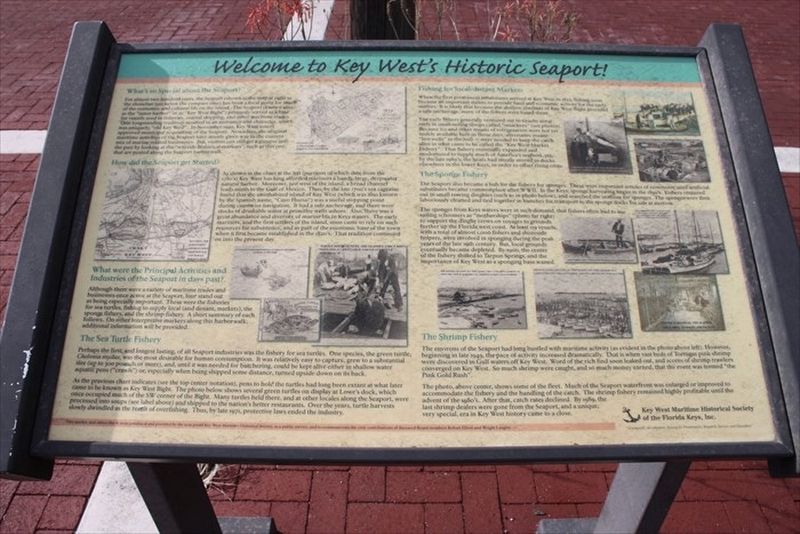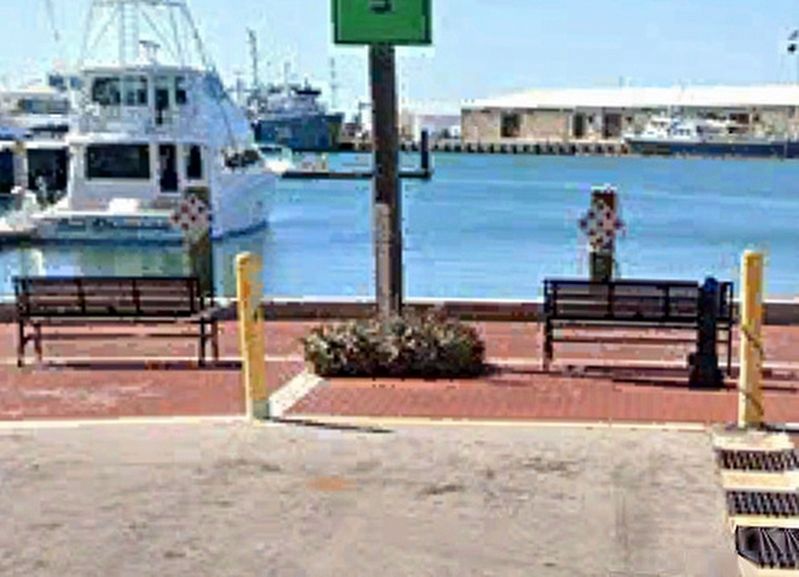Key West in Monroe County, Florida — The American South (South Atlantic)
Welcome to Key West's Historic Seaport!
For almost two hundred years, the Seaport (shown in the map at right as the shoreline just below the compass rose) has been a focal point for much of the economic and cultural life on the island. The Seaport (known also as the"inner harbor" or as "Key West Bight") primarily served as a base for vessels used in fisheries, coastal shipping, and other maritime trades. That longstanding tradition resulted in an ambience and character, which was uniquely, "old Key West". In November 1992, Key West voters approved municipal acquisition of the Seaport. Nowadays, the original maritime activities of the Seaport have mostly given way to the current mix of marine related businesses. But, visitors can still get a glimpse into the past by looking at the "wayside historical markers", such as this one, that are posted along the Seaport harbor walk.
How did the Seaport get started?
As shown in the cart at the left (portions of which date from the 1780's) Key West has long afforded mariners a handy, large, deepwater natural harbor. Moreover, just west of the island, a broad channel leads north to the Gulf of Mexico. Thus, by the late 1700's seas captains found that the uninhabited island of Key West (which was also known by the Spanish name, "Cayo Hueso") was a useful stopping point during coastwise navigation. It had a safe anchorage, and there were stocks of drinkable water at primitive wells ashore. Also, there was a great abundance and diversity of marine life in Keys waters. The early mariners, and the first settlers of the island, soon came to rely on such resources for subsistence, and as part of the economic base of the town when it first became established in the 1820's. That tradition continued on into the present day.
What were the Principal Activities and Industries of the Seaport in days past?
Although there were a variety of maritime trades and businesses once active at the Seaport, four stand out as being especially important. These were the fisheries for sea turtles, fishing to supply local (and distant, markets), the sponge fishery, and the shrimp fishery. A short summary of each follows. On other interpretive markers along this harborwalk, additional information will be provided.
The Sea Turtle Fishery
Perhaps the first, and longest lasting, of all Seaport industries was the fishery for sea turtles. One species, the green turtle Chelonia mydas, was the most desirable for human consumption. It was relatively easy to capture, grow to a substantial size (up to 300 pounds or more), and, until it was needed for butchering, could be kept alive either in shallow water aquatic pens ("crawls") or, especially
when being shipped some distance, turned upside down on its back.
As the previous chart indicates (see the top center notation), pens to hold the turtles had long been extant at what later came to be known as Key West Bight. The photo below shows several green turtles on display at Lowe's dock, which once occupied much of the SW corner of the Bight. Many turtles held there, and at other locales along the Seaport, were slowly dwindled as the result of overfishing. Thus, by late 1971, protective laws ended the industry.
Fishing for local/distant Markets
When the first permanent inhabitants arrived at Key West in 1822, fishing soon became an important means to provide food and economic activity for the early settlers. It is likely that because the shallow confines of Key West Bight provided a safe anchorage, many of the fishers were based there.
The early fishers generally ventured out to nearby coral reefs in small sailing sloops called "smackees" (see photos). Because ice and other means of refrigeration were not yet widely available here in those days, alternative means--"live wells" in the hull--were needed to keep the catch alive in what came to be called the "Key West Market Fishery". That fishery eventually expanded and modernized to supply much of America's seafood, yet, by the late 1980's, the boats had mostly moved to docks elsewhere on the lower Keys, in order to offset rising costs.
The Sponge Fishery
The Seaport also became a hub for the fishery for sponges. These were important articles of commerce until artificial substitutes became commonplace after WWII. In the Keys, sponge harvesting began in the 1850's. Fishers ventured out in small rowing dinghies (such as in photo below), and searched the seafloor for sponges. The sponges were then laboriously cleaned and tied together in bunches for transport to the sponge focus for sale at auction.
The sponges from Keys waters were in such demand, that fishers often had to use sailing schooners as "motherships" (photo far right) to support the dinghy crews on voyages to grounds further up the Florida west coast. At least 119 vessels, with a total of almost 1,000 fishers and shoreside helpers, were involved in sponging during the peak years of the late 19th century. But, local grounds eventually became depleted. By 1900, the center of the fishery shifted to Tarpon Springs, and the importance of Key West as a sponging base waned.
The Shrimp Fishery
The environs of the Seaport had long bustled with maritime activity (as evident in the photo above left). However, beginning in late 1949, the pace of activity increased dramatically. That is when vast beds of Tortugas pink shrimp were discovered in Gulf waters off Key West. Word of the rich find soon leaked out, and scores of shrimp trawlers converged on Key West. So much shrimp were caught, and so much money earned, that the event was termed "the Pink Gold Rush".
The photo, above center, shows some of the fleet. Much of the Seaport waterfront was enlarged or improved to accommodate the fishery and the handling of the catch. The shrimp fishery remained highly profitable until the advent of the 1980's. After that, catch rates declined. By 1989, the last shrimp dealers were gone from the Seaport, and a unique, very special, era in Key West history came to a close.
Erected by Key West Maritime Historical Society of the Florida Keys, Inc.
Topics. This historical marker is listed in these topic lists: Industry & Commerce • Settlements & Settlers • Waterways & Vessels. A significant historical year for this entry is 1780.
Location. 24° 33.751′ N, 81° 47.955′ W. Marker is in Key West, Florida, in Monroe County. Marker is on Grinnell Street, 0.1 miles north of Caroline Street, in the median. Marker is located at the end of Grinnell Street at the dock. Touch for map. Marker is at or near this postal address: 100 Grinnell Street, Key West FL 33040, United States of America. Touch for directions.
Other nearby markers. At least 8 other markers are within walking distance of this marker. Ferry Boats (here, next to this marker); Flagler's Train Terminal (within shouting distance of this marker); The Steamplant (within shouting distance of this marker); The Railroad that Died at Sea (about 400 feet away, measured in a direct line); The Maggie Atwell House (about 500 feet away); Key West Electric Company (about 500 feet away); Southern Terminus the Over-Sea Railway (about 500 feet away); Turtle Kraals Museum (about 500 feet away). Touch for a list and map of all markers in Key West.
Credits. This page was last revised on June 17, 2020. It was originally submitted on June 17, 2020, by Tim Fillmon of Webster, Florida. This page has been viewed 165 times since then and 11 times this year. Photos: 1, 2. submitted on June 17, 2020, by Tim Fillmon of Webster, Florida. • Bernard Fisher was the editor who published this page.

